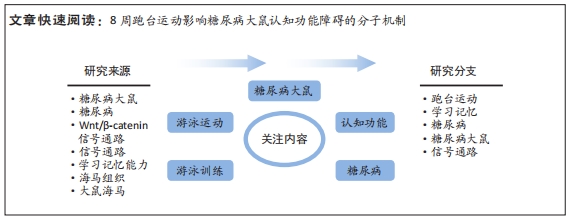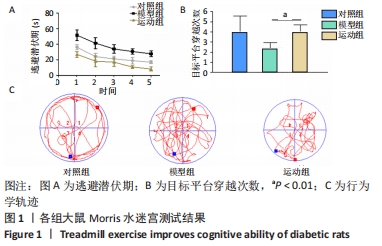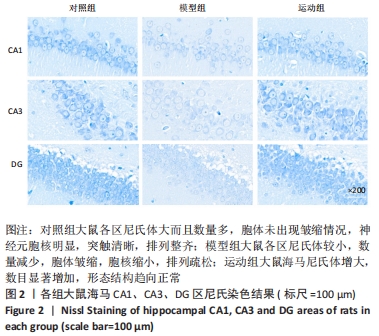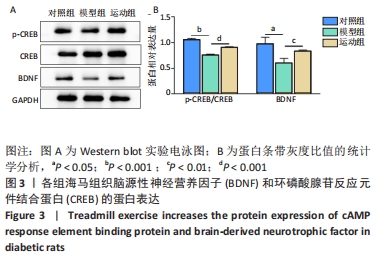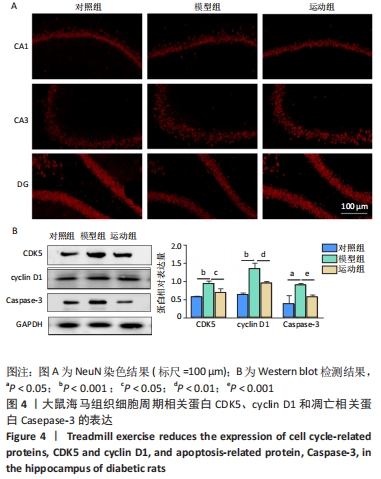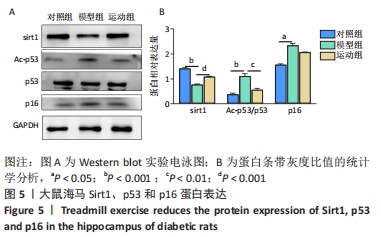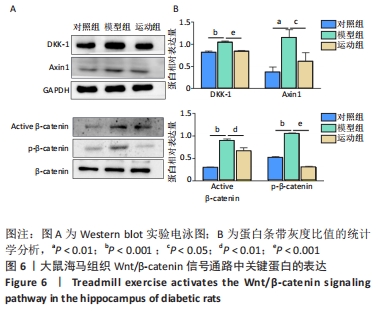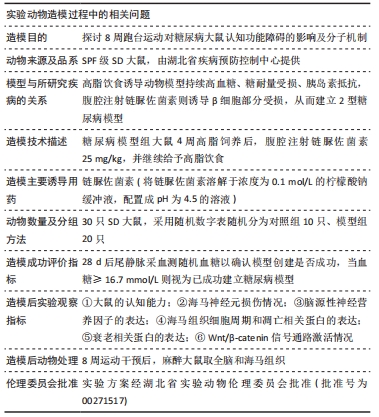[1] 王君佩, 杨吉春. 长非编码RNA与糖尿病及其并发症[J]. 生理科学进展, 2020,51(1): 1-7.
[2] KAUTZKY-WILLER A, HARREITER J, PACINI G. Sex and Gender Differences in Risk, Pathophysiology and Complications of Type 2 Diabetes Mellitus. Endocr Rev. 2016;37(3):278-316.
[3] RIEDERER P, KORCZYN AD, ALI SS, et al. The diabetic brain and cognition. J Neural Transm (Vienna). 2017;124(11):1431-1454.
[4] TEO ZL, THAM YC, YU M, et al. Global Prevalence of Diabetic Retinopathy and Projection of Burden through 2045: Systematic Review and Meta-analysis. Ophthalmology. 2021;21(S0161-6420):32-13.
[5] 牟严艳,叶中慧,林梅珍,等. 糖尿病流行病学研究进展[J]. 糖尿病新世界, 2019,22(4):196-198.
[6] UMEGAKI H, HAYASHI T, NOMURA H, et al. Cognitive dysfunction: An emerging concept of a new diabetic complication in the elderly. Geriatr Gerontol Int. 2013;13(1):28-34.
[7] NUSSE R, CLEVERS H. Wnt/β-Catenin Signaling, Disease, and Emerging Therapeutic Modalities. Cell. 2017;169(6):985-999.
[8] NARVAES RF, FURINI CRG. Role of Wnt signaling in synaptic plasticity and memory. Neurobiol Learn Mem. 2021;187:107558.
[9] LIBRO R, BRAMANTI P, MAZZON E. The role of the Wnt canonical signaling in neurodegenerative diseases. Life Sci. 2016;158:78-88.
[10] HUANG P, YAN R, ZHANG X, et al. Activating Wnt/β-catenin signaling pathway for disease therapy: Challenges and opportunities. Pharmacol Ther. 2019;196(1):79-90.
[11] INESTROSA NC, TAPIA-ROJAS C, CERPA W, et al. WNT Signaling Is a Key Player in Alzheimer’s Disease. Handb Exp Pharmacol. 2021;269(1):357-382.
[12] GARCIA-VELAZQUEZ L, ARIAS C. The emerging role of Wnt signaling dysregulation in the understanding and modification of age-associated diseases. Ageing Res Rev. 2017;37(6):135-145.
[13] AGHAIZU ND, JIN H, WHITING PJ. Dysregulated Wnt Signalling in the Alzheimer’s Brain. Brain Sci. 2020;10(12):902.
[14] CHEN D, ZHANG Y, ZHANG M, et al. Exercise Attenuates Brain Aging by Rescuing Down-Regulated Wnt/β-Catenin Signaling in Aged Rats. Front Aging Neurosci. 2020;12(3):105-120.
[15] MENET R, BOURASSA P, CALON F, et al. Dickkopf-related protein-1 inhibition attenuates amyloid-beta pathology associated to Alzheimer’s disease. Neurochem Int. 2020;141(4):104-114.
[16] HERRANZ N, GIL J. Mechanisms and functions of cellular senescence. J Clin Invest. 2018;128(4):1238-1246.
[17] QU J, XIONG X, HUJIE G, et al. MicroRNA-132-3p alleviates neuron apoptosis and impairments of learning and memory abilities in Alzheimer’s disease by downregulation of HNRNPU stabilized BACE1. Cell Cycle. 2021;20(21):2309-2320.
[18] BARRETT T, STANGIS KA, SAITO T, et al. Neuronal Cell Cycle Re-Entry Enhances Neuropathological Features in AppNLF Knock-In Mice. J Alzheimers Dis. 2021; 82(4):1683-1702.
[19] MALHOTRA N, GUPTA R, KUMAR P. Pharmacological relevance of CDK inhibitors in Alzheimer’s disease. Neurochem Int. 2021;148(1):105-115.
[20] GUPTA R, JHA A, AMBASTA RK, et al. Regulatory mechanism of cyclins and cyclin-dependent kinases in post-mitotic neuronal cell division. Life Sci. 2021;285(2):1200-1216.
[21] 刘申贝, 戴瑛, 赵军宁. 糖尿病脑病的研究进展[J].中国药理学与毒理学杂志, 2019,33(6): 444-450.
[22] NAY K, SMILES WJ, KAISER J, et al. Molecular Mechanisms Underlying the Beneficial Effects of Exercise on Brain Function and Neurological Disorders. Int J Mol Sci. 2021;22(8):40-52.
[23] CHOI DH, KWON KC, HWANG DJ, et al. Treadmill Exercise Alleviates Brain Iron Dyshomeostasis Accelerating Neuronal Amyloid-β Production, Neuronal Cell Death, and Cognitive Impairment in Transgenic Mice Model of Alzheimer’s Disease. Mol Neurobiol. 2021;58(7):208-3223.
[24] BELAYA I, IVANOVA M, SORVARI A, et al. Astrocyte remodeling in the beneficial effects of long-term voluntary exercise in Alzheimer’s disease. J Neuroinflammation. 2020;17(1):271-290.
[25] MATINFAR P, PEERI M, AZARBAYJANI MA. Swimming exercise attenuates anxiety-like behavior by reducing brain oxidative stress in type 2 diabetic mice. Physiol Behav. 2021;237:113449.
[26] 税晓平, 李春莹, 曹艳霞, 等 . 有氧和抗阻运动干预2型糖尿病模型大鼠周围神经内质网应激相关蛋白的表达[J]. 中国组织工程研究,2021,25(11): 1693-1698.
[27] PALOMER E, BUECHLER J, SALINAS PC. Wnt Signaling Deregulation in the Aging and Alzheimer’s Brain. Front Cell Neurosci. 2019;13(6):227-240.
[28] ZHANG C, LI B. The correlation between LncRNA-17A expression in peripheral blood mononuclear cells and Wnt/β-catenin signaling pathway and cognitive function in patients with Alzheimer disease. Am J Transl Res. 2021;13(10):11981-11986.
[29] TAPIA-ROJAS C, INESTROSA NC. Wnt signaling loss accelerates the appearance of neuropathological hallmarks of Alzheimer’s disease in J20-APP transgenic and wild-type mice. J Neurochem. 2018;144(4):443-465.
[30] SALEM MA, BUDZYŃSKA B, KOWALCZYK J, et al. Tadalafil and bergapten mitigate streptozotocin-induced sporadic Alzheimer’s disease in mice via modulating neuroinflammation, PI3K/Akt, Wnt/β-catenin, AMPK/mTOR signaling pathway. Toxicol Appl Pharmacol. 2021;429:1156-1177.
[31] TORICELLI M, PEREIRA A A R, SOUZA ABRAO G, et al. Mechanisms of neuroplasticity and brain degeneration: strategies for protection during the aging process. Neural Regen Res. 2021;16(1):58-67.
[32] HERNANDEZ-ORTEGA K, QUIROZ-BAEZ R, ARIAS C. Cell cycle reactivation in mature neurons: a link with brain plasticity, neuronal injury and neurodegenerative diseases?. Neurosci Bull. 2011;27(3):185-196.
[33] LUKASIK P, ZALUSKI M, GUTOWSKA I. Cyclin-Dependent Kinases (CDK) and Their Role in Diseases Development-Review. Int J Mol Sci. 2021;22(6):29-35.
[34] ZHOU M, HUANG T, COLLINS N, et al. APOE4 Induces Site-Specific Tau Phosphorylation Through Calpain-CDK5 Signaling Pathway in EFAD-Tg Mice. Curr Alzheimer Res. 2016;13(9):1048-1055.
[35] LIU S L, WANG C, JIANG T, et al. The Role of Cdk5 in Alzheimer’s Disease. Mol Neurobiol. 2016;53(7):4328-4342.
[36] SHI J J, LIU H F, HU T, et al. Danggui-Shaoyao-San improves cognitive impairment through inhibiting O-GlcNAc-modification of estrogen α receptor in female db/db mice. J Ethnopharmacol. 2021;281:114562.
[37] AIN Q, SCHMEER C, PENNDORF D, et al. Cell cycle-dependent and -independent telomere shortening accompanies murine brain aging. Aging (Albany NY). 2018; 10(11):3397-3420.
[38] AL-KHALAF HH, NALLAR SC, KALVAKOLANU DV, et al. p16(INK4A) enhances the transcriptional and the apoptotic functions of p53 through DNA-dependent interaction. Mol Carcinog. 2017;56(7):1687-1702.
[39] MODI PK, JAISWAL S, SHARMA P. Regulation of Neuronal Cell Cycle and Apoptosis by MicroRNA 34a. Mol Cell Biol. 2016;36(1):84-94.
[40] CHAUHAN M, MODI PK, SHARMA P. Aberrant activation of neuronal cell cycle caused by dysregulation of ubiquitin ligase Itch results in neurodegeneration. Cell Death Dis. 2020;1(6):441-451.
[41] SAH E, KRISHNAMURTHY S, AHMIDOUCH MY, et al. The Cellular Senescence Stress Response in Post-Mitotic Brain Cells: Cell Survival at the Expense of Tissue Degeneration. Life (Basel). 2021;11(3):229-240.
[42] SOLTANIAN B, DEHGHAN SHASALTANEH M, RIAZI GH, et al. Alteration of gene expression in reactive astrocytes induced by Aβ1-42 using low dose of methamphetamine. Mol Biol Rep. 2021;48(8):6103-6112.
[43] KIM SH, KO YJ, KIM JY, et al. Treadmill Running Improves Spatial Learning Memory Through Inactivation of Nuclear Factor Kappa B/Mitogen-Activated Protein Kinase Signaling Pathway in Amyloid-β-Induced Alzheimer Disease Rats. Int Neurourol J. 2021;25(Suppl 1):S35-43.
[44] FARIOLI-VECCHIOLI S, TIRONE F. Control of the Cell Cycle in Adult Neurogenesis and its Relation with Physical Exercise. Brain Plast. 2015;1(1):41-54.
[45] BIANCHI A, MARCHETTI L, HALL Z, et al. Moderate Exercise Inhibits Age-Related Inflammation, Liver Steatosis, Senescence, and Tumorigenesis. J Immunol. 2021; 206(4):904-916.
[46] JIA L, PIÑA-CRESPO J, LI Y. Restoring Wnt/β-catenin signaling is a promising therapeutic strategy for Alzheimer’s disease. Mol Brain. 2019;12(1):104-120.
[47] REN C, GU X, LI H, et al. The role of DKK1 in Alzheimer’s disease: A potential intervention point of brain damage prevention?. Pharmacol Res. 2019;144:331-335.
[48] BAYOD S, FELICE P, ANDRÉS P, et al. Downregulation of canonical Wnt signaling in hippocampus of SAMP8 mice. Neurobiol Aging. 2015;36(2):720-729.
[49] JIN N, ZHU H, LIANG X, et al. Sodium selenate activated Wnt/β-catenin signaling and repressed amyloid-β formation in a triple transgenic mouse model of Alzheimer’s disease. Exp Neurol. 2017;297:36-49.
[50] WANG J, JING Y, SONG L, et al. Neuroprotective effects of Wnt/β-catenin signaling pathway against Aβ -induced tau protein over-phosphorylation in PC12 cells. Biochem Biophys Res Commun. 2016;471(4):628-632.
[51] NING WJ, LV RJ, XU N, et al. Lycopene-Loaded Microemulsion Regulates Neurogenesis in Rats with Aβ-Induced Alzheimer’s Disease Rats Based on the Wnt/β-catenin Pathway. Neural Plast. 2021;2021:5519330.
[52] 张楠, 王莉智, 杨桂姣, 等. 自主跑轮运动对阿尔兹海默病模型小鼠认知、情绪以及杏仁核炎性因子表达的影响[J]. 神经解剖学杂志,2017,33(6):741-747.
|
